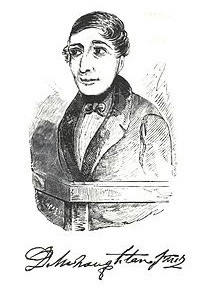Mental health and the law
Mental health is one of the leading factors affecting the justice system in Canada. Despite the provision of mental health services in recent decades, considerable police resources are tied up with mental health issues and these problems also are present in Canada’s courts and corrections facilities. In addition, there are mental health costs for victims of crime.
In the past, prior to the development of expertise in medicine, psychology and psychiatry, the mental capacity of accused offenders was not always recognized. The jails were a catch-all facility for not only offenders but also the poor, the infirm and the mentally ill.
Daniel McNaughten, 1843
 In 19th century England, the McNaughten (sometimes spelled M’Naghten) case helped formalize the legal defence of ‘insanity’ (now commonly referred to a ‘mental disorder’). Daniel McNaughten was a Scottish wood worker who attempted to assassinate British prime minister Sir Robert Peel in 1843. Instead he shot and killed Peel’s secretary, Edward Drummond.
In 19th century England, the McNaughten (sometimes spelled M’Naghten) case helped formalize the legal defence of ‘insanity’ (now commonly referred to a ‘mental disorder’). Daniel McNaughten was a Scottish wood worker who attempted to assassinate British prime minister Sir Robert Peel in 1843. Instead he shot and killed Peel’s secretary, Edward Drummond.
The jury ruled that McNaughten was not guilty of murder by reason of insanity. Today McNaughten would probably be diagnosed as a schizophrenic. The prisoner was sent to Bethlem Hospital and eventually to the Broadmoor Criminal Lunatic Asylum, where he died in 1865. Following this ruling a panel of judges reviewed the law and formulated the so-called McNaughten rules for determining the legal defence of not guilty by reason of insanity. The rules were eventually adopted by courts in the United States and Canada.
The most famous case in Canadian history connected to the issue of criminal insanity was the High Treason Trial of Louis Riel in 1885. Riel, an educated Métis, had led the resistance to the Canadian takeover of the Red River area in 1869-70. During that conflict the provisional government headed by Riel had executed a Canadian, Thomas Scott.
In 1885 Riel was placed on trial for treason for his role on the North West Rebellion. Despite a past history of mental illness (which included a stay in asylums in Quebec from 1876 to 1878), Riel refused to enter a plea of not guilty by reason of insanity. Two doctors testified at the trial at which he was found guilty and sentenced to be executed. The federal government, in reviewing the case (and aware of the intense political feelings surrounding it) appointed a commission of two mental health specialists to advise on the prisoner’s competency. The commission ruled that Riel was sane and he was sent to the gallows.
In the past, those found to be legally insane were detained in hospitals, often indefinitely. In the early 1990s, a decision of the Supreme Court of Canada followed by amendments to the Criminal Code, procedures for dealing with persons were are “not criminally responsible by reasons of mental disorder” were modernized. Courts were required to replace indefinite hospital terms with maximum sentences.
Another innovation in recent years has been the selective introduction of mental health courts. Judges, prosecutors and defence lawyers by the late 20th century were noticing that the criminal courts and jail were like a ‘revolving door’ for the mentally ill and intellectually impaired. Not only were many of these individuals not receiving mental health services, they were also a burden on the workload of provincial courts.
Canada’s first official mental court began in Toronto in 1998 and the model spread. The goals have included diverting the mentally ill from custody (for example, under remand). These courts use a team approach, and each case involved a judge, a Crown attorney, defence counsel, a psychiatrist and or community health workers and often a social worker. The Saint John Mental Health was formally made part of the provincial court system in 2003.
